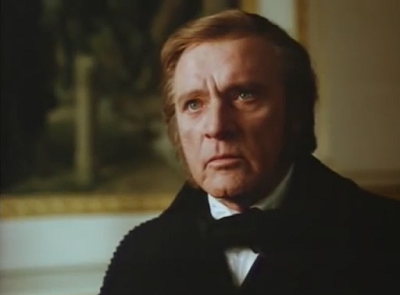by Paul J. Pelkonen

Obsessive genius: Sir Richard Burton as Richard Wagner in Wagner.
Image © 1983 Hungarofilm/Kultur.
Wagner boasts a dazzling cast (including major Shakespearean actors and several prominent Wagner singers of the late '70s and early '80s. They are led by Sir Richard Burton, fulfilling a lifelong ambition in the title role. Filmed in many of the actual locations where Wagner lived and worked, the visuals are accompanied by excerpts from 11 different Wagner operas played by the London Symphony Orchestra under the reliable baton of Sir Georg Solti. This film is exhaustive and exhausting. Like Wagner's longest operas (themselves only half as long as this film's nine hours,) Palmer's biopic requires both faith and endurance.
Fleeing to Switzerland, Wagner finds asylum with his investor, the banker Otto von Wesendonck (Richard Pasco) and more importantly his wife Mathilde (Marthe Keller). This torrid (but and possibly unconsummated) romance angers Minna but also inspired Tristan und Isolde. In these scenes, the viewer can hear the first strains of Wagner's "music of the future" emerge from the piano. The performance of the first "Tristan chord" is a thrilling moment, coming just as this ill-fated romance bursts into flower. When Minna intercepts one of Mathilde's love notes to Richard, Otto throws the Wagners out of his lakeside cottage. Having lost his home (again) and destroyed his marriage, Wagner is on the move.
The film follows Wagner's wanderings. He goes to Venice, where he is haunted by street bandas playing Rienzi and watched by Austro-Hungarian authorities. He completes the orchestration of Tristan by turning the police officers set to watch him into a team of copyists! In Paris, his planned triumph with a re-orchestrated Tannhäuser is soured by an ugly (and fictionalized) lobby confrontation with rival composer Giacomo Meyerbeer. (Vernon Dobtcheff) Mr. Palmer fudges the truth here, suggesting that Meyerbeer as responsible for the riotous disruption of the opening night of Tannhäuser. And then rescue arrives, in the form of the Bavarian monarch, King Ludwig II.
Played by the vibrant Hungarian actor Lázló Gáiffi, Ludwig is a complicated figure lost in his own fantasies, the only man in this vast canvas who may be as crazy as Wagner himself. But
the completion of Tristan, Die Meistersinger and finally the Ring would not have happened without Ludwig's patronage, although Wagner treats his royal "friend" very badly indeed. At this point, Cosima von Bulow (Vanessa Redgrave) becomes an important figure and the complex triangle between her, her husband the conductor Hans von Bulow and Wagner himself echoes the libretto of Tristan itself. The film details the torturous Munich premiere of that opera (and at the same time the birth of Wagner's first, illegitimate child with Cosima, named Isolde.) The ensuing scandal and Wagner's proflagate spending forces Richard and Cosima to flee once more for Switzerland.
Watch the Dresden Uprising riot scene from Wagner.
It is Vanessa Redgrave's restrained, serene and at times silent turn as Cosima that makes the second half of Wagner work. She is the calm center in Wagner's life, and yet beneath that quiet exterior beats the heart of a fanatic, the founder of what would become the composer's own personal cult. The tenderest moment in Wagner comes in the Triebschen years, when she gets her ultimate reward: waking up to the sweet strains of the Siegfried Idyll, performed here (on location) with the musicans on inner steps of the Wagners' lakeside villa. The last act moves to Bayreuth and details the struggles in building and financing the Bayreuth Festspiel and the artistic challenges faced and defeated with the first production of the Ring and Parsifal.
Charles Wood's screenplay does not shy away from the composer's ugly rhetoric and anti-Semitism, although the film makes quick work of the Parsifal years. Here, Wagner is shown at the end of his turbulent life, still railing and ranting against a world that had finally accepted his art. The nasty proto-Nazi rhetoric is very noticeable in the last of the film, as Wagner insults his creditors, regularly overextends himself and comes to loggerheads with Nietzsche (Richard Pasco), his father-in-law Liszt (Ekkehard Schall) and finally Cosima. On February 13, 1883, Wagner had an argument over his latest affair, (with the singer Carrie Pringle, one of the Flower Maidens in Parsifal.) He died of a fatal heart attack, but as this film points out, his music live on.

